UC Santa Cruz has been awarded $350,000 in combined grant and donor funds for a major upgrade to the Kast Spectrograph at Lick Observatory.
Astronomers throughout the UC system use the Kast Spectrograph for scientific research across a broad range of observational programs. Its powerful and flexible double-camera design makes it the most important and most used instrument on the 3-meter Shane Telescope at Lick Observatory, located on Mount Hamilton east of San Jose.
Bill and Marina Kast, the donors for whom the instrument is named, initiated the current upgrade program with a $50,000 donation announced in early 2014. Major funding for the upgrade was provided by a $300,000 grant from the Heising-Simons Foundation.
“With this award, we will be bringing the Kast up to the standards of the best observatories in the world,” said Brad Holden, a research astronomer at UC Santa Cruz and principal investigator for the Kast upgrade project. “We will be able to make observations that can currently only be done at a handful of places.”
Black holes and supernovae
The spectrograph is used to analyze faint celestial objects at distances ranging from our own solar system to the far reaches of the universe. Astronomers research the chemical composition of stars, probe the surroundings of massive black holes, and study massive intergalactic hydrogen clouds, among other projects.
Alex Filippenko, professor of astronomy at UC Berkeley, said the Kast Spectograph is crucial for his team’s long-term study of supernovae, or exploding stars. “The Kast spectrograph is unique at Lick Observatory,” said Filippenko. “It allows astronomers to obtain spectra of objects over the complete optical range, from the near-ultraviolet to the near-infrared.”
The spectrograph itself is two distinct instruments. Separate CCD detectors analyze and record wavelengths in the blue and red ranges independently and at the same time. The blue and red spectra are then combined to form a spectrum that covers the entire visible wavelength band, giving astronomers a more complete view of distant objects.
With the new funding, the UC Observatories instrument labs at UC Santa Cruz will modernize the red detector to make it as sensitive and powerful as the blue side of the spectrograph.
“With the upgraded red side of the Kast spectrograph, our data will be even better,” said Filippenko, who played a major role in securing both the grant and private donation. “For example, we will be able to more accurately calibrate supernovae in our quest to understand the nature of the dark energy that is accelerating the expansion of the universe."
City lights
The new red-side detector will also have properties that allow for more accurate removal of light from the city lights of the Santa Clara valley. Up on Mount Hamilton, 16 miles east of San Jose, the emission of nearby city lights can occasionally dilute the view through the telescopes. With greatly improved sensitivity at redder wavelengths, the upgrade will help astronomers probe deeper into the distant universe and observe it as it appeared at earlier times.
“When the Kast was first designed and built in the early 1990s, it was right at the cutting edge in spectrometer efficiency and precision,” said Michael Bolte, a professor of astronomy and astrophysics at UC Santa Cruz who helped to secure the grant. “Although we have made a number of improvements to continually modernize the instrument, the work funded by the Kasts and Heising-Simons Foundation will allow us to bring the instrument right to the world-leading forefront again. This is wonderful news for UC astronomers.”
The Heising-Simons Foundation was established in 2007 by Mark Heising and Elizabeth Simons to advance sustainable solutions in the environment, enhance the education of young learners, and support groundbreaking research in science. News of the secured funds for the upgrade project comes just after UC announced their continued support of Lick Observatory at the end of October.
“This is more great news for Lick Observatory,” said Claire Max, interim director of UC Observatories. “This upgrade will help keep Lick Observatory at the forefront of astronomical surveys and research for the future.”
UC Observatories is the system-wide astronomical research unit that operates Lick Observatory, as well as the technical labs at UC Santa Cruz and UCLA, and acts as one of the managing partners of the W. M. Keck Observatory in Hawaii. UCO is also the center for the UC participation in the Thirty Meter Telescope (TMT) project, now under construction in Hawaii.
“This is an exciting time to bring new projects aboard,” said Max. “Our expert staff at the instrument labs will continue to push the envelope with next generation technology for Keck, the Thirty Meter Telescope, and now Lick Observatory.”



